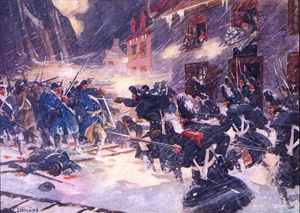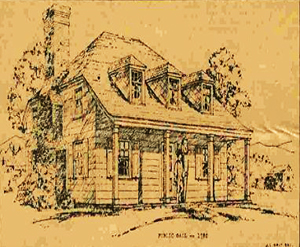Oakland History Reconsidered
Recap of Oakland History Presentation
Installment #5
By Kevin Heffernan
The Bergen County Courthouse Comes To Oakland
Oakland Sheriff Hangs Prisoner Without a Trial
We Oaklanders take great pride in the historical fact that in 1780 the Bergen County Courthouse was moved to Oakland. Of course, we think, where else would it be moved to other than here, this fine valley, with its law-abiding citizenry. Oakland was, we think, the first, the best and the natural choice. However, the facts tell a different story.
This article is about the how’s and why’s of the arrival of the Bergen County Courthouse in Oakland in 1780 during the American Revolution. It is also about the hanging of a prisoner of the Court in Oakland without a trial by, of all people, the official Bergen County Sheriff himself!
The Patriot Problem
In 1778 the New Jersey Legislature recognized that Hackensack in general and the courthouse specifically were at risk because of their proximity by either land or water to New York City then controlled by the British. In addition to that the British strongly objected to the presence of a system of laws and justice administered by the rebels within a territory they controlled. Clearly, a different location was needed for our courthouse.
Courts on the Run
 So, in November of 1779 the Bergen County Courthouse was moved to the Albert Hopper farm in what is now HoHoKus. The location was the first choice and, as it turns out, was not the very best one because the British soon found out about it and burned Mr. Hopper’s farm to the ground on April 16, 1780, a mere 6 months after its relocation from Hackensack.
So, in November of 1779 the Bergen County Courthouse was moved to the Albert Hopper farm in what is now HoHoKus. The location was the first choice and, as it turns out, was not the very best one because the British soon found out about it and burned Mr. Hopper’s farm to the ground on April 16, 1780, a mere 6 months after its relocation from Hackensack.
Undeterred and determined to have our own laws and justice, in May, 1780 the courthouse was then moved to the farm of Martin Reyerson then located in Saddle River, the second albeit forced choice. Well, Saddle River isn’t far from HoHoHus and the British soon found out about it’s new location. And, yes, they soon burned Mr. Reyerson’s farm to the ground.
Clearly, the British were sending a flaming message to the Patriots of Bergen County as an expression of their displeasure over the courthouse. And to make sure that the message was properly delivered, the British burned the courthouse in Hackensack to the ground for good measure on March 22, 1780.
The Oakland Solution
 So far in 1780, the Bergen County Courthouse scorecard was: Burned courthouses 3, Patriots 0. Clearly, both a new strategy and a new location was needed. The Patriots finally figured out that both HoHoKus and Saddle River were simply too close to Hackensack and were very vulnerable to the ease of a British attack. Therefore, distance from the British and difficulty in approach were the keys to the safe haven for the Bergen County Courthouse. After a quick look at the map of Bergen County, they determined that indeed Oakland was the ideal location as it was virtually the furthest distance from New York City of any location and had the greatest degree of difficulty in reaching it. Oakland was 30 miles from NYC with at least 2 rivers to cross. It would take the British about a week to reach Oakland thereby providing plenty of time to pack up and move again before they arrived. And as a bonus, there were only about 50-60 people in the entire valley living in 8 houses including the Van Allen House.
So far in 1780, the Bergen County Courthouse scorecard was: Burned courthouses 3, Patriots 0. Clearly, both a new strategy and a new location was needed. The Patriots finally figured out that both HoHoKus and Saddle River were simply too close to Hackensack and were very vulnerable to the ease of a British attack. Therefore, distance from the British and difficulty in approach were the keys to the safe haven for the Bergen County Courthouse. After a quick look at the map of Bergen County, they determined that indeed Oakland was the ideal location as it was virtually the furthest distance from New York City of any location and had the greatest degree of difficulty in reaching it. Oakland was 30 miles from NYC with at least 2 rivers to cross. It would take the British about a week to reach Oakland thereby providing plenty of time to pack up and move again before they arrived. And as a bonus, there were only about 50-60 people in the entire valley living in 8 houses including the Van Allen House.
So it was that Oakland was chosen to be the location of the new Bergen County Courthouse albeit the third choice. Accordingly, the Legislature authorized a new courthouse to be built on land leased from Peter Hendrick Van Allen in Oakland. The exact location is where the current Exxon gas station is today. In the interim though, the decision was also made to use the Van Allen House as the Bergen Courthouse until the new one was built.
And for the second time during the American Revolution, Mr. Van Allen and his wife most likely moved again to the barn to the dismay of his cows. The first time was when George Washington made an overnight visit on July 14, 1777. It is noted that Van Allen’s second barn arrangement was less than satisfactory (to the cows?) and before too long the court was moved to the Ponds Church while the new 20 x 40, 2 story log courthouse and gaol (jail) were being built.
Colonial Justice in Oakland – Hang’m Without a Trial
Every jail needs a sheriff to fill it and the jail here in Oakland was no exception. Records show that the sheriff in Oakland was Sheriff Manning and he was not a man to be trifled with. The American troops in Fort Lee captured one Mr. Collington as a spy for the British who was promptly sent to the spanking new log jail in Oakland. It is important to know that the life expectancy of a captured spy then was really short and apparently Mr. Collington was aware that his odds of living to a ripe old age were somewhere between nil and none.
While in the Oakland jail on a cold, stormy, winter night, he requested to be able to make a fire for warmth. But his plan was to set the jail on fire and make his escape during the chaos and confusion. Well, although he did make a fire and set the jail ablaze, the fire was discovered quickly and his plan failed. Sheriff Manning, living close by, was immediately awakened and notified of Mr. Collington’s attempts. Upon arrival at the jail, Sheriff Manning placed Mr. Collington in chains and beat him to a pulp with a large club. Pleased but not satisfied, Sheriff Manning returned to the jail the next day, pronounced that Collington was clearly guilty of being a spy and promptly had him hanged by the neck from an impromptu scaffold behind the jail without the inconvenience of a trial. Collington was buried behind the courthouse which places his grave behind the Exxon gas station.
Oakland was the home of the Bergen County Courthouse for 6 years, Since the American Revolution lasted until 1783 and the Bergen County Courthouse had to be rebuilt after it was torched by the British, the Bergen County Courthouse stayed in Oakland until 1786 after which it moved back to Hackensack. The ownership of courthouse building itself reverted to Mr. Van Allen and Oakland went back to sleep to the delight of his cows.
As a footnote, there is incredible irony in the fact that a prisoner was beaten and hung without the benefit of a trial at a time when this nation was fighting for life, liberty and the pursuit of happiness inclusive of a trial by jury. And it is more ironic that the prisoner was hung by the sheriff who is charged with the responsibility of upholding the law! But then again, those were the days in old Oakland when ‘justice’ was both swift and decisive. And finally, this writer leaves it for the reader to judge the wisdom of permitting a prisoner to make a fire in a structure made entirely of wood.
Next week we will explore the history of the Ponds Church and the incredible impact that it has had upon our community for over 300 years since 1710.
Kevin Heffernan – kheffernan@gmail.com

Again another informative and amusing bit of Oakland History. Thanks.
Curious to know if Mr. Collington’s remains are still behind the Exxon. If so, couldn’t that land the property on the National Registry of Historic Places? At the very least, a plaque or similar marker at the site would seem to be in order. We tout Washington’s visit to Oakland prominently in the town’s history (as we should) so it would seem that such an event would also be an important part of the town’s history and role during the war.
Keith,
There is a report from the turn of the Century by an aged individual whose grandfather remembered the event and noted that there was an mound at the unmarked grave site of Collington that was known to all Oaklanders. I suspect that it was simply ignored with the development of the gas station and the housing behind it. The remains of Colington are probably still there.
Very interesting Kevin. I’m sure my son would want to do a paranormal investigation down there if he knew about it.
Great stuff! Please keep sharing.